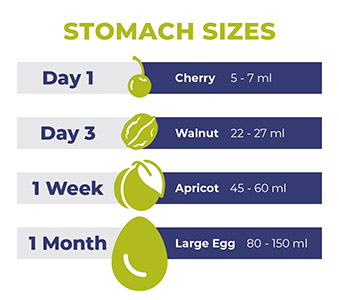For new parents, feeding your baby can feel overwhelming. How often, how much and what to feed baby are very common questions whether you’re a new parent, grandparent or it’s been a few years.
Both breast milk and formula offer excellent nutrition for infants, and they are all your baby needs in their diet for their first 6 months. Your pediatrician may recommend vitamin D and/or iron drops as supplements for your baby, but this should be discussed with your baby’s doctor. Solid foods can be introduced once your baby can sit up with support and has good head and neck control, which usually happens around 6 months. Some babies may show an interest in solid foods before this, and if baby has good head and neck control, parents can introduce solids between 4 and 6 months old, making sure to avoid any choking hazards. If baby spits out the solids, that’s a sign they are not ready. Just wait a little while and try again in (a couple days/weeks/or when). Learn more about starting solids.

Most newborns want to eat frequently in the first few weeks. Their stomachs are small, so think small amounts but often. Newborns should feed at least every 2 to 3 hours during the day and every 4 hours at night until they're showing good weight gain, which is usually by 2 to 3 weeks of age. After this, you can follow your baby's hunger cues and allow them to sleep more than 4 hours at a time. Cues that by is hungry might include sucking motions, rooting (turning head to one side and opening mouth or sticking out tongue), squirming and looking more alert.
There are many different breastfeeding styles, and they can vary between children. Some babies are more energetic or eager, while others may be slower to start or like resting while feeding. Becoming aware of the typical feeding style of your infant can help you find ways to optimize breastfeeding. For example, if your baby is slow to start feeding, it may help to express a few drops of breast milk from your nipple until they secure their latch.
The CDC offers these tips for preparing and storing powdered infant formula:
When it comes to storing breast milk, freshly pumped milk can last 4 hours at room temperature or 4 days in the refrigerator. Thawed breast milk has a shorter timeline, and once your baby starts a bottle, it's best to use it within 2 hours. Learn more here.
For formula, use prepared formula within 2 hours at room temperature or within 24 hours if stored in the refrigerator. However, once your baby starts a bottle of formula, use it within 1 hour - do not store bottles that have been drank out of for later. Learn more here.
If you have specific questions or concerns about feeding your baby, talk with a Prevea Pediatrician.
Both breast milk and formula offer excellent nutrition for infants, and they are all your baby needs in their diet for their first 6 months. Your pediatrician may recommend vitamin D and/or iron drops as supplements for your baby, but this should be discussed with your baby’s doctor. Solid foods can be introduced once your baby can sit up with support and has good head and neck control, which usually happens around 6 months. Some babies may show an interest in solid foods before this, and if baby has good head and neck control, parents can introduce solids between 4 and 6 months old, making sure to avoid any choking hazards. If baby spits out the solids, that’s a sign they are not ready. Just wait a little while and try again in (a couple days/weeks/or when). Learn more about starting solids.

Most newborns want to eat frequently in the first few weeks. Their stomachs are small, so think small amounts but often. Newborns should feed at least every 2 to 3 hours during the day and every 4 hours at night until they're showing good weight gain, which is usually by 2 to 3 weeks of age. After this, you can follow your baby's hunger cues and allow them to sleep more than 4 hours at a time. Cues that by is hungry might include sucking motions, rooting (turning head to one side and opening mouth or sticking out tongue), squirming and looking more alert.
Breastfeeding
Sometimes breastfeeding comes easily, and other times it can be very challenging. Remember to be kind, empathic and patient with yourself and with baby. Lactation consultants are an excellent source of support, and many mothers find breastfeeding support groups helpful. Talk with your OB/GYN, midwife or primary care provider about breastfeeding resources available in your area.There are many different breastfeeding styles, and they can vary between children. Some babies are more energetic or eager, while others may be slower to start or like resting while feeding. Becoming aware of the typical feeding style of your infant can help you find ways to optimize breastfeeding. For example, if your baby is slow to start feeding, it may help to express a few drops of breast milk from your nipple until they secure their latch.
Formula feeding
Formula-fed infants will generally take larger, more spaced-out feedings than breastfed babies. For the first few weeks, a newborn will take 2 to 3 ounces of prepared formula every 3 to 4 hours. As time goes on, you’ll learn your baby’s cues and develop a regular feeding routine.The CDC offers these tips for preparing and storing powdered infant formula:
- Make sure that the formula can is in good condition with no signs of distress.
- Wash your hands and workspace before preparing formula in a clean bottle and nipple.
- Use water from a safe source.
- Follow the instructions on the formula container, including the amount of water and formula to use. Always measure the water first and then add the powdered formula.
- Shaken, not stirred: always shake the bottle to mix rather than stirring.
- You do not need to warm infant formula before feeding. If you decide to warm the formula, do not use the microwave. Instead, warm it under running warm water or in a bowl of warm water, avoiding getting water into the bottle or nipple. Formula should not ever feel hot.
- Thoroughly clean the bottle and nipple before next use.
Bottle feeding and milk storage
When it comes to bottle feeding breast milk or formula, the CDC suggests positioning the bottle at an angle, not straight up and down, to control the flow of the milk. Let your baby take breaks when they seem to want them, and stop feeding when they show signs of being full, even if the bottle isn't empty. Signs of being full could include closing their mouth, turning their head away and relaxing their hands rather than having them clenched.When it comes to storing breast milk, freshly pumped milk can last 4 hours at room temperature or 4 days in the refrigerator. Thawed breast milk has a shorter timeline, and once your baby starts a bottle, it's best to use it within 2 hours. Learn more here.
For formula, use prepared formula within 2 hours at room temperature or within 24 hours if stored in the refrigerator. However, once your baby starts a bottle of formula, use it within 1 hour - do not store bottles that have been drank out of for later. Learn more here.
If you have specific questions or concerns about feeding your baby, talk with a Prevea Pediatrician.



